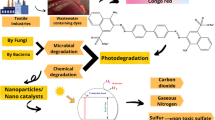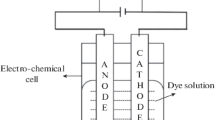Abstract
Conventional vat dyeing involves chemical reduction of dyes into their water-soluble leuco form generating considerable amounts of toxic chemicals in effluents. In the present study, a new β-nicotinamide adenine dinucleotide disodium salt (NADH)-dependent reductase isolated from Bacillus subtilis was used to reduce the redox dyes CI Acid Blue 74, CI Natural Orange 6, and CI Vat Blue 1 into their water-soluble leuco form. Enzymatic reduction was optimized in relation to pH and temperature conditions. The reductase was able to reduce Acid Blue 74 and Natural Orange 6 in the presence of the stoichiometrically consumed cofactor NADH; meanwhile, Vat Blue 1 required the presence of mediator 1,8-dihydroxyanthraquinone. Oxygen from air was used to reoxidize the dyes into their initial forms. The enzymatic reduction of the dyes was studied and the kinetic constants determined, and these were compared to the chemically-reduced leuco form. The enzyme responsible for the reduction showed homology to a NADH-dependent reductase from B. subtilis based on results from the MS/MS peptide mass mapping of the tryptically digested protein. Additionally, the reduction of Acid Blue 74 to its leuco form by reductase from B. subtilis was confirmed using NADH regenerated by the oxidation of formic acid with formate dehydrogenase from Candida boidinii in the same solution.







Similar content being viewed by others
References
Badri BM, Burkinshaw SM (1993) Dyeing of wool and nylon 6.6 with henna and lawsone. Dyes Pigm 22(1):15–25
Baumgarte U (1987) Reduction and oxidation processes in dying with vat dyes. Melliand Textilber Int 68:189–195
Bechtold T, Turcanu A (2006) Iron-complexes of bis(2-hydroxyethyl)-amino-compounds as mediators for the indirect reduction of dispersed vat dyes—cyclic voltammetry and spectroelectrochemical experiments. J Electroanal Chem 591:118–126
Blackburn RS, Harvey A (2004) Green chemistry methods in sulfur dyeing: application of various reducing d-sugars and analysis of the importance of optimum redox potential. Environ Sci Technol 38(14):4034–4039
Božič M, Kokol V (2008) Ecological alternatives to the reduction and oxidation processes in dyeing with vat and sulphur dyes. Dyes Pigm 76:299–309
Božič M, Crepinsek Lipus L, Kokol V (2008) Magnetic field effects on redox potential of reduction and oxidation agents. Croat Chem Acta 81(3):413–421
Božič M, Kokol V, Guebitz GM (2009) Indigo dyeing of polyamide using enzymes for dye reduction. Tex Res J 79(10):895–907
Gasana E, Westbroek P, Temmerman E, Thun HP, Kiekens P (2003) A wall-jet disc electrode for simultaneous and continuous on-line measurement of sodium dithionite, sulfite and indigo concentrations by means of multistep chronoamperometry. Anal Chim Acta 486(1):73–83
Heo J, Halbleib CM, Ludden PW (2001) Redox-dependent activation of CO dehydrogenase from Rhodospirillum rubrum. Proc Natl Acad Sci USA 98(14):7690–7693
Kirkland D, Marzin D (2003) An assessment of the genotoxicity of 2-hydroxy-1,4-naphthoquinone, the natural dye ingredient of henna. Mutat Res 537(2):183–199
Kohno Y, Kitamura S, Yamada T, Sugihara K, Ohta S (2005) Production of superoxide radical in reductive metabolism of a synthetic food-coloring agent, indigocarmine, and related compounds. Life Sci 77(6):601–614
Kroutil W, Mang M, Edegger K, Faber K (2004) Recent advances in the biocatalytic reduction of ketones and oxidation of sec-alcohols. Curr Opin Chem Biol 8:120–126
Leonida MD (2001) Redox enzymes used in chiral syntheses coupled to coenzyme regeneration. Curr Med Chem 8:345–369
Lowry OH, Rosebrough NJ, Farr AL, Randall RJ (1951) Protein measurement with the folin phenol reagent. J Biol Chem 193:265–275
Maier J, Kandelbauer A, Erlacher A, Cavaco-Paulo A, Guebitz GM (2004) A new alkali-thermostable azoreductase from Bacillus sp strain SF. Appl Environ Microbiol 70:837–844
Mesentsev AV, Lamzin VS, Tishkov VI, Ustinnikova TB, Popov VO (1997) Effect of pH on kinetic parameters of NAD-dependent formate dehydrogenase. Biochem J 321:475–480
Nicholson SK, John P (2004) Bacterial indigo reduction. Biocatal Biotransfor 22(5&6):397–400
Nicholson SK, John P (2005) The mechanism of bacterial indigo reduction. Appl Microbiol Biot 68:117–123
Othman I, Mohamed RM, Ibrahim IA, Mohamed MM (2006) Synthesis and modification of ZSM-5 with manganese and lanthanum and their effects on decolorization of indigo carmine dye. Appl Catal A-Gen 299:95–102
Padden AN, John P, Colins MD, Hutson R, Hall AR (2000) Indigo-reducing Clostridium isatidis isolated from a variety of sources, including a 10th-century Viking dye vat. J Archaeol Sci 27:953–956
Pricelius S, Held C, Sollner S, Deller S, Murkovic M, Ullrich R, Hofrichter M, Cavaco-Paulo A, Macheroux P, Guebitz GM (2007a) Enzymatic reduction and oxidation of fibre-bound azo-dyes. Enzyme Microb Technol 40(7):1732–1738
Pricelius S, Held C, Murkovic M, Bozic M, Kokol V, Cavaco-Paulo A, Guebitz GM (2007b) Enzymatic reduction of azo and indigoid compounds. Appl Microbiol Biotechnol 77(2):321–327
Shevchenko A, Jensen ON, Podtelejnikov AV, Sagliocco F, Wilm M, Vorm O, Mortensen P, Boucherie H, Mann M (1996a) Linking genome and proteome by mass spectrometry: large-scale identification of yeast proteins from two dimensional gels. Proc Natl Acad Sci USA 93:14440–14445
Shevchenko A, Wilm M, Vorm O, Mann M (1996b) Mass spectrometric sequencing of proteins from silver-stained polyacrylamide gels. Anal Chem 68:850–858
Siu E, Won K, Park CB (2007) Electrochemical regeneration of NADH using conductive vanadia–silica xerogels. Biotechnol Prog 23(1):293–296
Van der Zee FP, Cervantes FJ (2009) Impact and application of electron shuttles on the redox (bio)transformation of contaminants: a review. Biotechnol Adv 27:256–277
Vuorema A, John P, Keskitalo M, Kulandainathan MA, Marken F (2008) Electrochemical and sonoelectrochemical monitoring of indigo reduction by glucose. Dyes Pigm 76(2):542–549
Wolf M (2000) Sulfites, thiosulfates, and dithionites, Ulmann's encyclopedia of industrial chemistry. Wiley-VCH Verlag, Weinheim
Yumoto I, Hirota K, Nodasaka Y, Yokota Y, Hoshino T, Nakajima K (2004) Alkalibacterium psychrotolerans sp. nov., a psychrotolerant obligate alkaliphile that reduces an indigo dye. Int J Syst Evol Microbiol 54:2379–2383
Acknowledgements
This research was supported by the Slovenian Research Agency (J2-7018-0795) and the Slovenia–Austria 2007–2008 scientific and technological collaboration program.
Author information
Authors and Affiliations
Corresponding author
Rights and permissions
About this article
Cite this article
Božič, M., Pricelius, S., Guebitz, G.M. et al. Enzymatic reduction of complex redox dyes using NADH-dependent reductase from Bacillus subtilis coupled with cofactor regeneration. Appl Microbiol Biotechnol 85, 563–571 (2010). https://doi.org/10.1007/s00253-009-2164-8
Received:
Revised:
Accepted:
Published:
Issue Date:
DOI: https://doi.org/10.1007/s00253-009-2164-8




